As someone who is truly fascinated by colorful birds—especially those with brilliant blue feathers—I find Maryland to be an exceptional place to explore. From deep forests to open fields and quiet wetlands, this state offers diverse habitats that attract a surprising variety of blue-colored bird species during different seasons.
This article on 12 Blue Birds in Maryland introduces some of the most striking and beloved birds you can find throughout the state. From the vivid Blue Jay and the elegant Tree Swallow to the rare and treasured Cerulean Warbler, each species brings its own beauty, song, and behavior to the Maryland landscape.
Blue-feathered birds are not only visually stunning but also offer incredible birdwatching experiences. Blue Birds in Maryland can be seen darting across ponds, singing from treetops, or flashing their colors in summer meadows. For anyone who appreciates nature’s artistry, these birds are unforgettable highlights.
Common Blue Birds Found in Maryland
Eastern Bluebird (Sialia sialis)
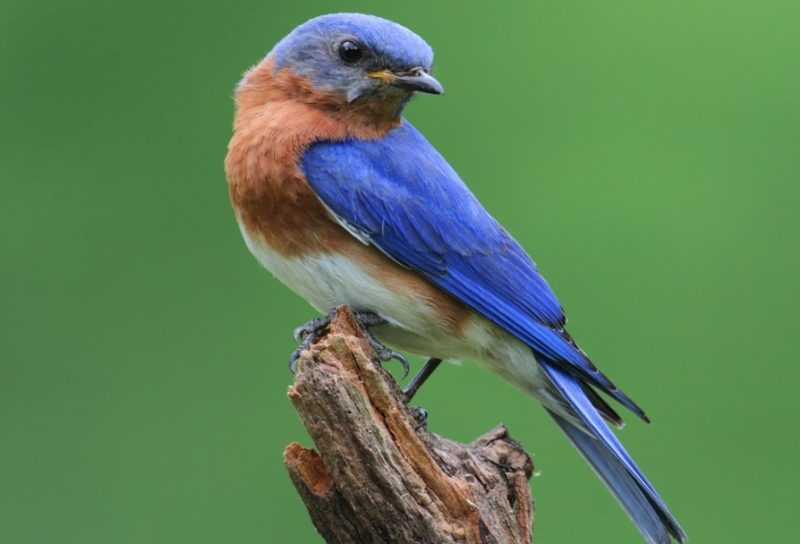
The Eastern Bluebird is a small thrush with vibrant blue upperparts and a warm, rusty-red throat and chest. Males are especially vivid, while females appear more muted with grayish-blue tones and lighter reddish coloring. This bird has a rounded head, straight bill, and relatively short tail. Adults typically measure about 6.5 to 7 inches in length with a wingspan of 9.8 to 12.6 inches, making them compact but easily recognizable in open habitats.
One of the most charming aspects of the Eastern Bluebird is its soft, melodious song composed of warbles and whistles. Their call is a gentle “cheer cheerful charmer,” which is often repeated during the breeding season. These birds primarily feed on insects and other invertebrates during warmer months, switching to berries and fruits in fall and winter. Their diet includes grasshoppers, caterpillars, beetles, and spiders, along with dogwood, holly, and juniper berries.
Eastern Bluebirds prefer open country with scattered trees and low ground cover, such as meadows, pastures, and clearings. They frequently use nest boxes and will often return to the same location if the conditions remain favorable. They nest in cavities, including old woodpecker holes and artificial nest boxes, making them popular among backyard birders who help conserve their populations.
In Maryland, Eastern Bluebirds are present year-round but are most frequently seen in the central and southern regions. They are especially active during the spring and summer breeding seasons and are often spotted perched on fence posts, telephone wires, or fluttering low across grassy fields. Thanks to conservation efforts and the widespread use of nest boxes, their populations have rebounded significantly across the state.
Blue Jay (Cyanocitta cristata)

The Blue Jay is one of Maryland’s most recognizable and charismatic birds. It boasts a striking blue coloration on the upperparts, a white face and underparts, and bold black markings around the neck and across the face. The prominent crest on its head can be raised or lowered depending on the bird’s mood. These birds are fairly large, measuring about 9 to 12 inches long with a wingspan of 13 to 17 inches, making them one of the larger songbirds in the region.
Blue Jays are known for their loud, harsh calls, including the familiar “jay jay” sound. However, they are also capable mimics and often imitate hawk calls, which can confuse both other birds and birdwatchers. Their vocal range also includes soft whistles and chatters. These intelligent birds are omnivores, feeding on acorns, nuts, seeds, fruits, insects, and even small vertebrates or bird eggs when given the opportunity.
Behaviorally, Blue Jays are both curious and cautious. They are social birds often seen in family groups or loose flocks, especially during the non-breeding season. They are known to cache food for later use, particularly acorns, which helps in forest regeneration. They are also frequent visitors to bird feeders, where they dominate smaller species with their assertive behavior and loud presence.
In Maryland, Blue Jays are permanent residents and are commonly found throughout the state. They thrive in a variety of habitats, including mixed woodlands, suburban areas, parks, and backyards. They prefer areas with oak trees and water sources, as these provide both food and nesting opportunities. Their adaptability and intelligence make them successful in both rural and urban environments.
Indigo Bunting (Passerina cyanea)
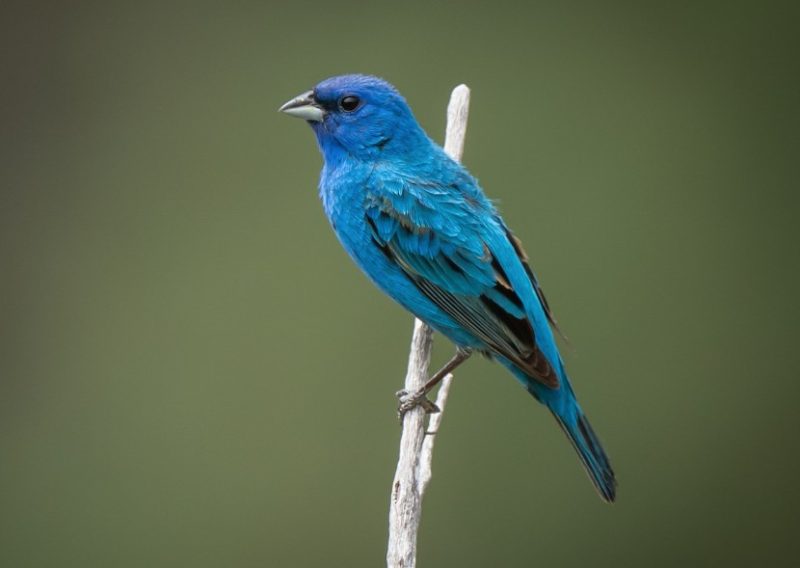
The Indigo Bunting is a small, vibrant songbird most admired for the dazzling blue plumage of the male during the breeding season. Males are a solid, deep indigo blue all over, while females and juveniles are brown with faint streaking and subtle bluish hints on the wings or tail. These birds are about 4.5 to 5.1 inches long with a wingspan of approximately 7.5 to 9 inches, making them slightly smaller than a sparrow.
This species has a cheerful, high-pitched song composed of short, paired notes often delivered from exposed perches. Males sing persistently throughout the day during the breeding season to establish and defend their territory. Indigo Buntings feed on seeds, berries, buds, and insects such as caterpillars and beetles. During migration, they may also consume small grains or other available plant material.
They are typically found in shrubby habitats, forest edges, overgrown fields, roadsides, and areas recovering from logging or fire. They avoid dense forests and wide-open areas, instead favoring semi-open landscapes where they can perch and forage. Indigo Buntings often nest low in shrubs or small trees, and both parents help feed the young after hatching.
In Maryland, Indigo Buntings are migratory, arriving in late April or May and staying through the summer before heading south in September or October. They breed across much of the state, especially in areas with early successional growth. Birders can spot them singing from wires, fence lines, or the tops of young trees in rural areas and nature preserves during the warmer months.
Tree Swallow (Tachycineta bicolor)
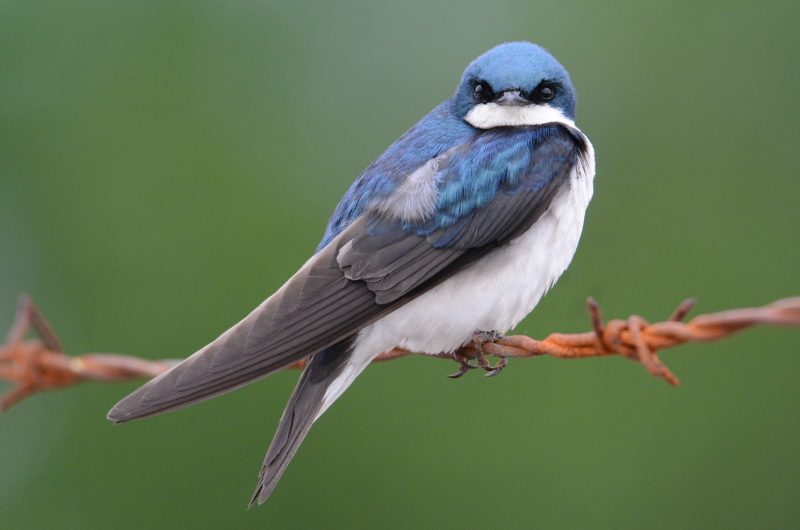
The Tree Swallow is a sleek, medium-sized swallow with glossy blue-green upperparts and bright white underparts. Males display more iridescent coloration, while females may appear slightly duller or browner. These birds are 5.1 to 5.9 inches long with a wingspan of 11.8 to 13.8 inches. Their pointed wings and forked tail enable graceful, acrobatic flight, often seen swooping over water or fields.
Tree Swallows produce a liquid, gurgling song and a variety of soft chirps and twitters while in flight or perched. Their vocalizations are gentle compared to other swallows and often heard during social interactions. Their diet consists primarily of flying insects, such as flies, mosquitoes, and beetles, but they also consume berries, particularly bayberries, when insect prey is scarce.
These swallows are cavity nesters, often using tree holes or man-made nest boxes near water or open spaces. They are highly social and sometimes form loose colonies. During the breeding season, males arrive early to secure nesting sites and defend them until females arrive. After nesting, large flocks can be observed roosting together before fall migration begins.
In Maryland, Tree Swallows breed throughout the state during spring and summer. They are most commonly found near marshes, ponds, lakeshores, and open meadows where water and flying insects are abundant. After breeding, they migrate to the southern United States, Central America, or the Caribbean, typically departing Maryland by mid-October. Conservation groups often place nest boxes in appropriate areas to support local populations.
Barn Swallow (Hirundo rustica)

The Barn Swallow is a graceful and agile flyer, known for its deeply forked tail, iridescent deep blue back and head, and rusty-orange underparts. Its forehead and throat are a richer reddish-brown, contrasting with its cream-colored belly. Measuring about 6.7 to 7.5 inches in length with a wingspan of 11.4 to 12.6 inches, this slender-bodied swallow is one of the most familiar and widespread aerial insectivores in North America.
Barn Swallows are constantly in motion, emitting a cheerful, twittering song and series of chattering calls while they swoop low over fields, pastures, ponds, and roads. Their primary food source is flying insects, including flies, mosquitoes, and beetles, which they catch mid-air using their broad, open bills. They often drink and bathe on the wing by skimming the water’s surface.
These birds are known for their affinity to human structures and frequently build mud nests under the eaves of barns, bridges, culverts, and porches. They form monogamous pairs during the breeding season and are protective of their nesting sites. Barn Swallows often return to the same nesting area each year, and young birds may even nest close to where they hatched.
In Maryland, Barn Swallows are migratory, arriving in late March or April and staying until early October. They are widespread throughout the state during the breeding season, especially in open rural landscapes, near water, or wherever insects are abundant. They are commonly seen gliding and darting over open spaces, making them a favorite among birdwatchers during the warmer months.
Purple Martin (Progne subis)
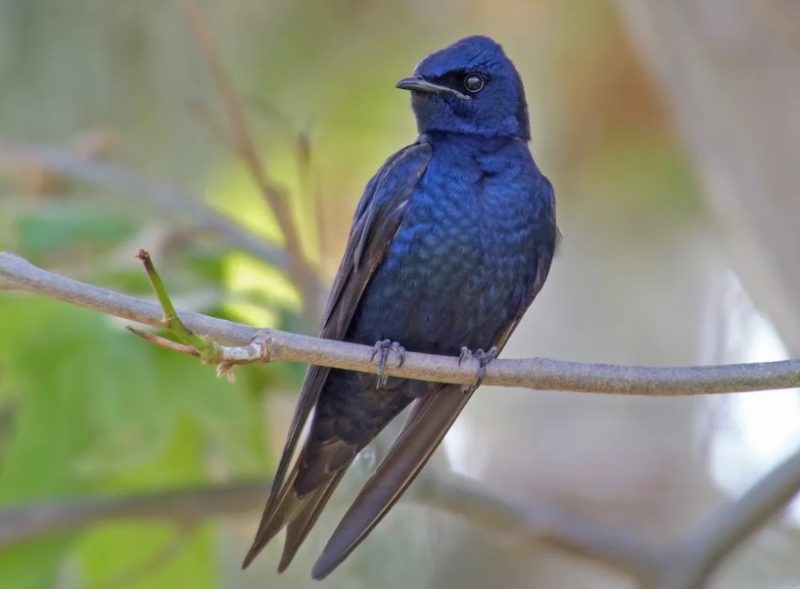
The Purple Martin is the largest swallow in North America, easily recognized by its broad chest, deeply forked tail, and shimmering dark blue-purple plumage. Adult males have an almost entirely glossy purplish-black appearance, while females and juveniles are duller with lighter bellies and less iridescence. These robust birds measure about 7.5 to 8.7 inches long with a wingspan of 15.3 to 16.1 inches.
Purple Martins are noted for their rich, bubbling, and gurgling songs, which they produce both in flight and while perched. They are aerial insectivores and feed primarily on large flying insects like dragonflies, moths, wasps, and beetles. Their long, pointed wings allow them to fly high and far from nesting colonies in search of prey.
They are highly social and nest in colonies, almost exclusively in human-provided housing in the eastern United States. Traditional gourd houses and large martin apartment-style houses placed in open fields or yards near water are commonly used. These birds return to the same colonies each year, often occupying the same compartments if available.
In Maryland, Purple Martins are migratory and arrive in spring, usually in late March to early April after wintering in South America. They breed throughout the state where suitable nesting structures are provided, especially in open fields or near water bodies. Their presence is most notable in suburban and rural communities where martin houses are maintained for conservation purposes.
Blue Grosbeak (Passerina caerulea)
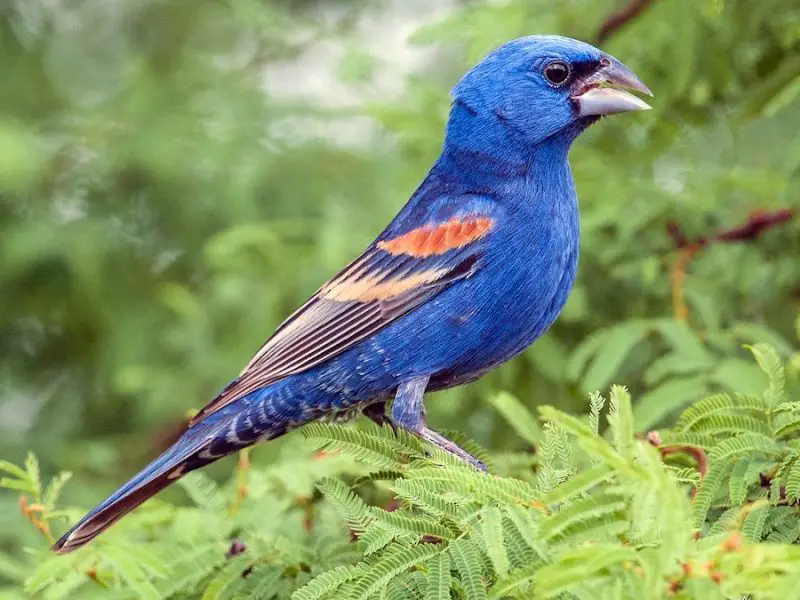
The Blue Grosbeak is a medium-sized, stocky songbird with rich blue plumage that is most vivid in adult males. A striking feature is the pair of chestnut-colored wing bars that stand out against its otherwise blue feathers. Females are warm brown with subtle bluish tinges and fainter wing bars. These birds measure about 5.5 to 7.5 inches in length with a wingspan of roughly 10 to 11 inches.
This species has a melodious, warbling song and a sharp metallic “chink” call. Males sing from exposed perches to attract mates and defend their territory. Blue Grosbeaks feed on a combination of seeds, grains, and insects such as grasshoppers, caterpillars, and beetles. They often forage on the ground or in low vegetation, especially during the breeding season.
They are typically found in open or semi-open habitats such as weedy fields, hedgerows, roadside thickets, and brushy woodland edges. Blue Grosbeaks favor areas with dense low vegetation for nesting and open spots for singing and foraging. The female builds a cup-shaped nest, often low in shrubs, and incubates the eggs while the male helps defend the territory.
In Maryland, Blue Grosbeaks are a less common summer resident and are more frequently observed in the southern and eastern parts of the state. They arrive in late spring and remain through the summer months, typically departing by early fall. Although not as abundant as other songbirds, their vivid coloring and sweet song make them a prized sighting for local bird enthusiasts.
Cerulean Warbler (Setophaga cerulea)
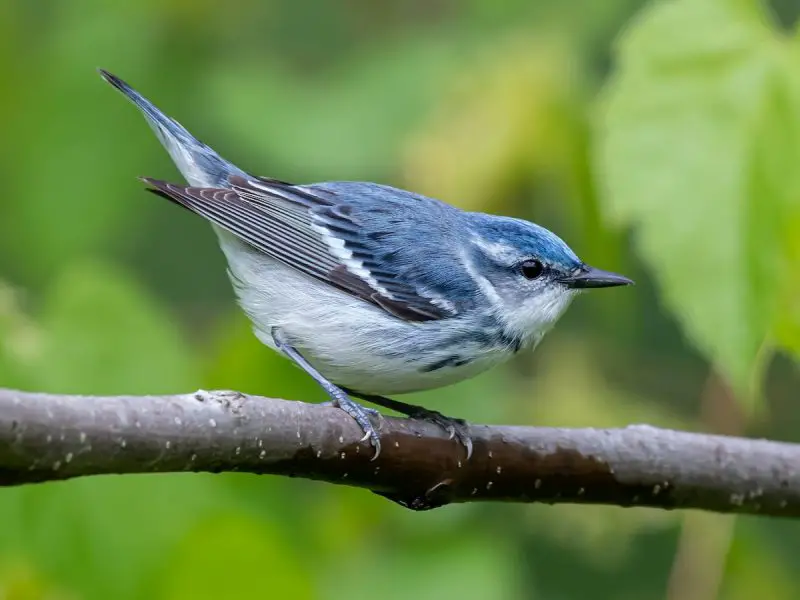
The Cerulean Warbler is a small, rare songbird known for its delicate powder-blue coloration and distinct white underparts marked with subtle streaking. Males display a brilliant sky-blue back, white wing bars, and a narrow dark band across the throat and chest. Females, though less striking, have a greenish-blue back and a pale yellowish wash on the belly. These birds are compact, measuring about 4.3 inches long with a wingspan of 7.9 inches.
Their song is a fast, buzzy trill that rises in pitch, often described as “zray-zray-zray-zree.” Cerulean Warblers feed primarily on insects, gleaning caterpillars, beetles, and flies from the high canopy. They are extremely agile and may occasionally hover or sally out to catch flying prey. Their foraging habits make them difficult to spot, as they often remain well above eye level.
This species is highly selective in its breeding habitat, preferring large tracts of mature deciduous forests with tall, closed canopies and sparse understory. They nest high in the canopy, building small, cup-shaped nests on horizontal branches. Cerulean Warblers are sensitive to habitat fragmentation and loss, which has contributed to their population decline across much of their range.
In Maryland, Cerulean Warblers are most likely to be found in the western part of the state during late spring and early summer, particularly in mountainous or forested regions like Garrett and Allegany Counties. These elusive warblers are best detected by sound, as their high-perched lifestyle makes them challenging to observe directly.
Black-throated Blue Warbler (Setophaga caerulescens)
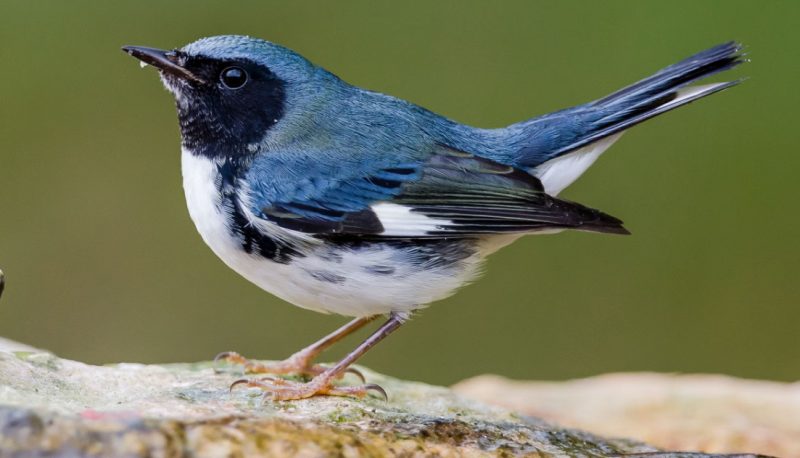
The Black-throated Blue Warbler is a small and striking warbler species, with the male showing a rich blue back, black face and throat, and stark white underparts. A signature white patch on the wing, often called a “pocket handkerchief,” helps with identification in the field. Females, in contrast, are drab olive-brown with a faint white line near the eye and little to no blue coloration, making them harder to recognize.
This warbler produces a simple yet distinctive song: a slow, buzzy “zoo-zoo-zoo-zheee,” often repeated from perches in dense shrubs or forest understories. They are insectivorous and forage deliberately, picking caterpillars, spiders, and other invertebrates from foliage and low branches. Their calm, methodical foraging behavior sets them apart from more frantic warblers.
During migration, Black-throated Blue Warblers are found in a variety of habitats, including mixed forests, parks, and wooded edges. They prefer understory-rich environments and are especially drawn to areas with a thick layer of shrubs or saplings. Their breeding range is in the northeastern United States and parts of Canada, where they nest in dense deciduous or mixed forests.
In Maryland, these birds are primarily seen during spring and fall migration as they pass through the state. Though not typically breeders here, birdwatchers can spot them in forested areas across Maryland during April-May and again in September-October. Males are much easier to identify, while females often go unnoticed without careful observation.
Northern Parula (Setophaga americana)

The Northern Parula is a tiny but vibrant warbler with a slate-blue back, greenish patch on the back, and a yellow chest that often fades into an orange band across the upper chest. Its throat and belly are mostly yellow and white, giving it a colorful yet compact appearance. Males are more colorful than females, but both share the same general pattern. These birds are about 4.3 inches long with a wingspan around 6.3 inches.
Northern Parulas sing a buzzy, rising trill that ends in a sharp note, often transcribed as “zeeeee-up!” This distinctive sound is commonly heard in spring as males proclaim their territory. They feed mainly on insects, especially caterpillars and spiders, which they pick from the surface of leaves or glean from hanging vegetation like Spanish moss or lichen.
They breed in moist forests, particularly those with a mix of deciduous and evergreen trees, where they build nests suspended from hanging lichens or mosses. The dense canopy provides shelter and abundant food, making these forests ideal habitats during the breeding season. Northern Parulas are especially tied to forest edges and riparian corridors.
In Maryland, Northern Parulas are spring and summer residents, particularly in the eastern half of the state. They are often found in wet, wooded areas along streams or swamps, especially where trees like sycamores or maples host the lichen or moss they use for nesting. Though not fully blue, their upperparts shimmer with a bluish sheen, earning them a place among Maryland’s “blue birds.”
Belted Kingfisher (Megaceryle alcyon)
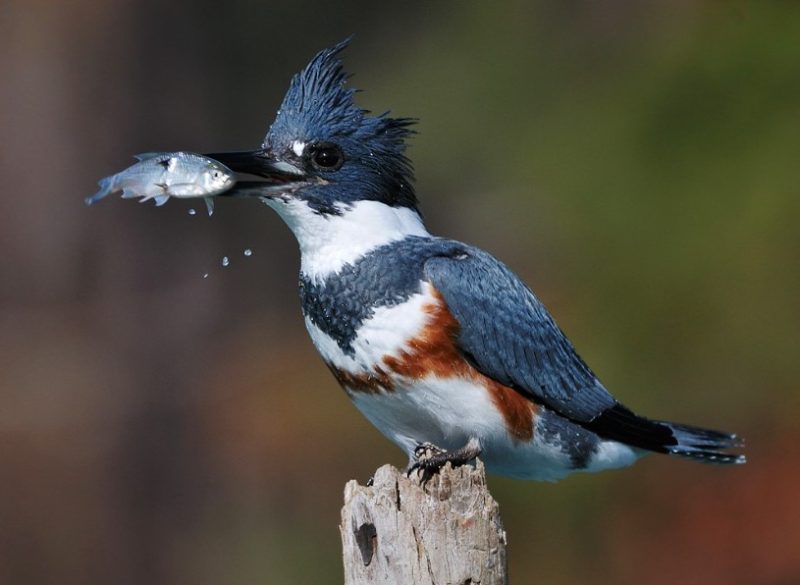
The Belted Kingfisher is a medium-sized bird with a slate-blue back and head, a white collar, and a shaggy, spiky crest that gives it a distinct silhouette. Males have a single blue chest band, while females—unusually for birds—are more colorful, with an additional rusty band across the belly. These birds are about 11 to 14 inches long with a wingspan of 19 to 23 inches, making them larger and stockier than songbirds.
Their call is a loud, rattling “klek-klek-klek,” often heard as they fly quickly along streams or rivers. Belted Kingfishers are specialized fish hunters, diving headfirst into the water to catch small fish and aquatic insects. They watch for prey from overhanging branches, wires, or other high vantage points near water.
These birds dig burrows in riverbanks or sandbanks, often several feet long, where they lay and incubate their eggs. They are highly territorial and are often seen perched alone or flying low over the water. Despite their solitary behavior, they are a regular sight near suitable aquatic habitats.
In Maryland, Belted Kingfishers are present year-round, though they may be less visible during winter when waters freeze. They are found across the state near rivers, lakes, ponds, and estuaries. Their striking color and rapid, low flight over water make them an unmistakable and exciting bird to observe, even if they’re not true “songbirds.”
Lazuli Bunting (Passerina amoena)
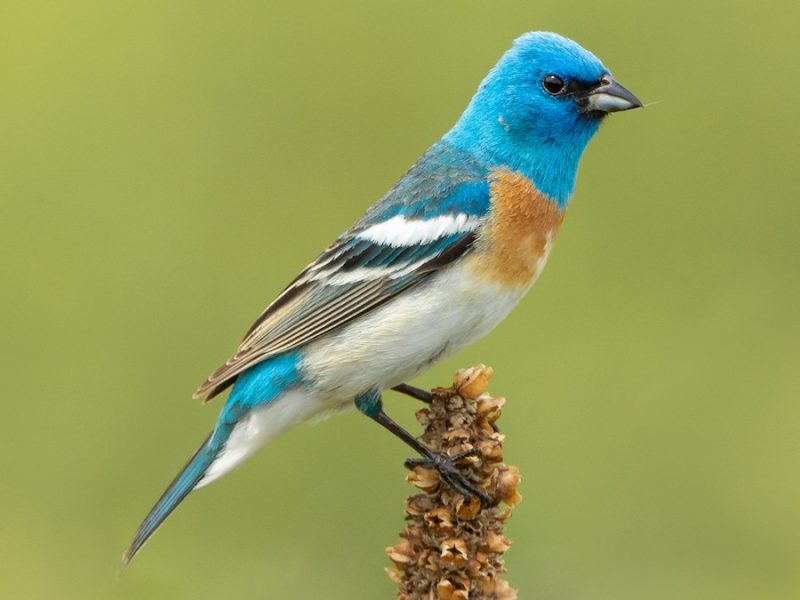
The Lazuli Bunting is a stunning, yet rare visitor to Maryland, primarily found in the western United States. Males have brilliant blue heads and backs, rich orange chests, and white bellies, creating a tricolor appearance that rivals even the most vibrant songbirds. Females are more subdued, with warm brown tones and faint bluish highlights. These birds are 5.1 to 5.9 inches long with a wingspan of about 8 inches.
Their song is a cheerful, warbling melody of clear notes, often compared to that of the Indigo Bunting but with a slightly more musical and varied tone. Lazuli Buntings are omnivorous, feeding on seeds, berries, and insects, and often forage in low shrubs or on the ground. They are energetic foragers and can be seen flitting through vegetation or perched in open brush.
This species breeds in open woodlands, brushy hillsides, and thickets, particularly where shrubs and young trees offer both cover and food. They are cavity nesters and frequently use low shrubs for their nests. Unlike many buntings, they readily use semi-urban areas if habitat conditions are favorable.
In Maryland, the Lazuli Bunting is a rare vagrant, occasionally spotted during migration but far outside its normal range. Birders may see one as an unexpected surprise in late spring or early fall, especially in open, brushy areas or at bird feeders. Their rarity in the region makes any sighting noteworthy among the local birdwatching community.
Best Time and Places to See Blue Birds in Maryland
The best time to see blue birds in Maryland is during the spring and summer months, from April through early September. This is when most blue-colored bird species, such as the Eastern Bluebird, Indigo Bunting, Barn Swallow, and Blue Grosbeak, are actively breeding, singing, and foraging. Migratory species like the Cerulean Warbler and Purple Martin also return to Maryland during this time, offering excellent viewing opportunities before they depart again in late summer or early fall. While some birds like the Blue Jay and Belted Kingfisher are present year-round, spring provides more activity and color as birds become more visible and vocal.
In terms of location, some of the best places to observe blue birds in Maryland include state parks, wildlife refuges, and open rural landscapes. For Eastern Bluebirds, open meadows and fields with nest boxes—like those at Patuxent Research Refuge or Soldiers Delight Natural Environment Area—are excellent spots. Wetland-rich areas such as Blackwater National Wildlife Refuge and Jug Bay Wetlands Sanctuary attract Tree Swallows, Barn Swallows, and Belted Kingfishers. Forested regions in western Maryland, particularly in Garrett and Allegany Counties, are ideal for seeing the rare Cerulean Warbler and other warbler species.
Birders looking for the most diversity should visit during early morning hours in late spring, when birds are most active. Nature trails, forest edges, and fields with scattered shrubs offer the best vantage points. Areas with active bird conservation programs, such as those that install Purple Martin houses or manage meadow habitats, also increase the likelihood of blue bird sightings. Whether you’re exploring coastal marshes or hiking in the Appalachian foothills, Maryland’s varied habitats provide rewarding opportunities to see these colorful and captivating birds.


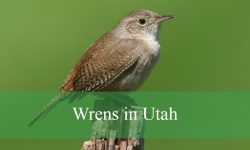

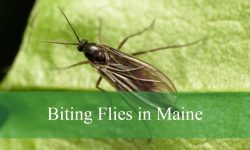
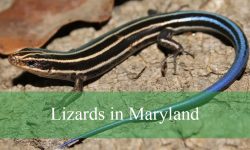
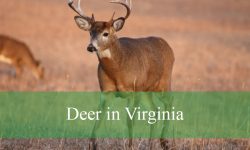
Is there any site online that I can hear the various songs of these birds?